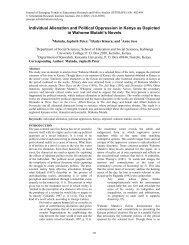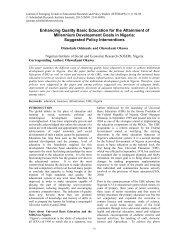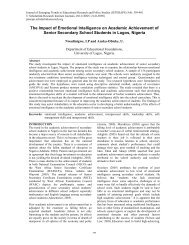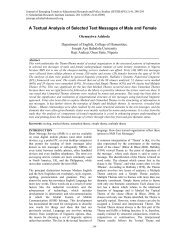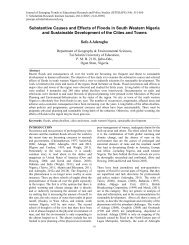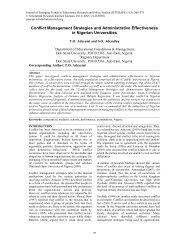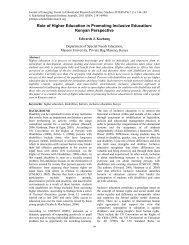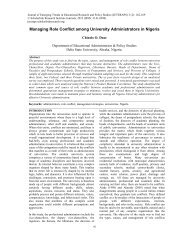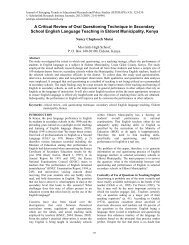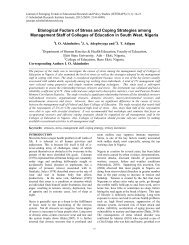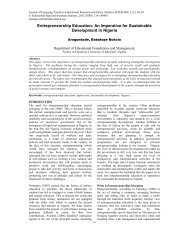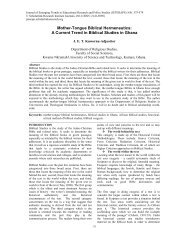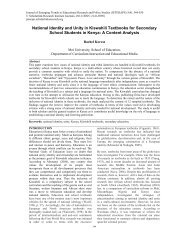Challenges and Reforms Facing Kenyan Education System in the ...
Challenges and Reforms Facing Kenyan Education System in the ...
Challenges and Reforms Facing Kenyan Education System in the ...
Create successful ePaper yourself
Turn your PDF publications into a flip-book with our unique Google optimized e-Paper software.
Journal of Emerg<strong>in</strong>g Trends <strong>in</strong> <strong>Education</strong>al Research <strong>and</strong> Policy Studies (JETERAPS) 3(4):471-478 (ISSN:2141-6990)<br />
Fig. 1.0 Primary completion rate <strong>and</strong> primary to<br />
secondary transition rate, 2004-2010<br />
Source: MoE Statistics department 2009<br />
Fig 1.1: Secondary schools gross enrolment rate<br />
(GER) <strong>and</strong> Net enrolment rate (NER) 2004-2010<br />
Source: MoE Statistics department 2009<br />
The number of secondary schools has <strong>in</strong>creased from<br />
a total of 6,566 secondary schools <strong>in</strong> 2008 to 7,308 <strong>in</strong><br />
2009 aga<strong>in</strong>st 26,666 primary schools over <strong>the</strong> same<br />
period. Enrolment grew from 1.18 million students <strong>in</strong><br />
2007 (639,393 boys <strong>and</strong> 540,874 girls) to 1,328,964<br />
(735,680 boys <strong>and</strong> 593,284 girls) students <strong>in</strong> 2008<br />
<strong>and</strong> fur<strong>the</strong>r to 1,500,015 (804,119 boys <strong>and</strong> 695,896<br />
girls) students <strong>in</strong> 2009. Figure 1.1 shows <strong>the</strong> GER for<br />
secondary <strong>in</strong>creased from 27.3 % (28.8% boys <strong>and</strong><br />
25.7% girls) <strong>in</strong> 1999 to 47.8 % (50.9% boys <strong>and</strong><br />
46.3% girls) <strong>in</strong> 2010. The NER recorded an <strong>in</strong>crease<br />
from 28.9 % (29.8 % male <strong>and</strong> 27.9 % female) <strong>in</strong><br />
2008 to 35.8 % (36.5 % boys <strong>and</strong> 35.1 % girls) <strong>in</strong><br />
2010 hav<strong>in</strong>g progressively improved from13.7 % <strong>in</strong><br />
1999. The gender disparity <strong>in</strong>dex as at 2009 stood at<br />
0.96% thus <strong>in</strong>dicat<strong>in</strong>g 1:1 ratio of boys to girls.<br />
Student transition rate from primary to secondary<br />
<strong>in</strong>creased marg<strong>in</strong>ally from 59.6 % (56.5 % male <strong>and</strong><br />
63.2 % female) <strong>in</strong> 2007 to 64.1 % (61.3 % male <strong>and</strong><br />
67.3 % female) <strong>in</strong> 2008. This fur<strong>the</strong>r <strong>in</strong>creased from<br />
66.9 % (64.1 % for male <strong>and</strong> 69.1 % for female) <strong>in</strong><br />
2009 to 72% <strong>in</strong> 2010.<br />
In 2008, 924,192 primary school children<br />
represent<strong>in</strong>g 10.8% of total enrolled were be<strong>in</strong>g<br />
educated <strong>in</strong> <strong>the</strong> private sector while 171,097<br />
secondary school children represent<strong>in</strong>g 12.31% of<br />
total enrolled were be<strong>in</strong>g educated <strong>in</strong> <strong>the</strong> private<br />
sector. Enrolment <strong>in</strong> private secondary schools rose<br />
from 83,733 students to 171,097 <strong>in</strong> 2008, whilst <strong>the</strong><br />
growth <strong>in</strong> <strong>the</strong> number of private secondary schools is<br />
far greater than that of public secondary schools <strong>in</strong><br />
any prov<strong>in</strong>ce. For example, <strong>in</strong> Nairobi <strong>the</strong> number of<br />
private <strong>and</strong> public secondary schools is almost <strong>the</strong><br />
same (47:48) (EMIS, 2009). However, fast growth <strong>in</strong><br />
numbers of private secondary schools has been<br />
restricted by shortage of affordable l<strong>and</strong>.<br />
474<br />
In 2008, 924,192 primary school children<br />
represent<strong>in</strong>g 10.8% of total enrolled were be<strong>in</strong>g<br />
educated <strong>in</strong> <strong>the</strong> private sector while 171,097<br />
secondary school children represent<strong>in</strong>g 12.31% of<br />
total enrolled were be<strong>in</strong>g educated <strong>in</strong> <strong>the</strong> private<br />
sector. Enrolment <strong>in</strong> private secondary schools rose<br />
from 83,733 students to 171,097 <strong>in</strong> 2008, whilst <strong>the</strong><br />
growth <strong>in</strong> <strong>the</strong> number of private secondary schools is<br />
far greater than that of public secondary schools <strong>in</strong><br />
any prov<strong>in</strong>ce. For example, <strong>in</strong> Nairobi <strong>the</strong> number of<br />
private <strong>and</strong> public secondary schools is almost <strong>the</strong><br />
same (47:48) (EMIS, 2009). However, fast growth <strong>in</strong><br />
numbers of private secondary schools has been<br />
restricted by shortage of affordable l<strong>and</strong>.<br />
<strong>Education</strong> <strong>Reforms</strong> Necessary to Align <strong>Education</strong><br />
Sector with Constitution 2010 <strong>and</strong> Vision 2030<br />
<strong>and</strong> Bill of Rights<br />
Under <strong>the</strong> Constitution, <strong>the</strong> cab<strong>in</strong>et will be limited to<br />
22 members from <strong>the</strong> current 40, which <strong>in</strong>evitably<br />
entails a new structure of management. It is strongly<br />
expected that <strong>the</strong> m<strong>in</strong>istry of education <strong>and</strong> <strong>the</strong><br />
m<strong>in</strong>istry of higher education, science <strong>and</strong> technology<br />
will merge <strong>in</strong>to one. This raises questions about <strong>the</strong><br />
size of <strong>the</strong> new education m<strong>in</strong>istry <strong>and</strong> <strong>the</strong> roles <strong>and</strong><br />
responsibilities of possible new directorates. Some of<br />
<strong>the</strong> functions rema<strong>in</strong><strong>in</strong>g at <strong>the</strong> national level <strong>in</strong>clude:<br />
policy <strong>and</strong> plann<strong>in</strong>g, st<strong>and</strong>ards <strong>and</strong> regulations,<br />
<strong>in</strong>formation technology, research. Whereas <strong>the</strong><br />
process of merg<strong>in</strong>g m<strong>in</strong>istries could br<strong>in</strong>g about<br />
efficiency, <strong>the</strong>re is also <strong>the</strong> possibility that ga<strong>in</strong>ed<br />
achievements <strong>in</strong> education could be lost. For this<br />
reason <strong>the</strong>re should be an agreed percentage of <strong>the</strong><br />
education funds target<strong>in</strong>g specific units thus; preprimary,<br />
primary, secondary, polytechnics, teacher<br />
tra<strong>in</strong><strong>in</strong>g <strong>and</strong> special education.



